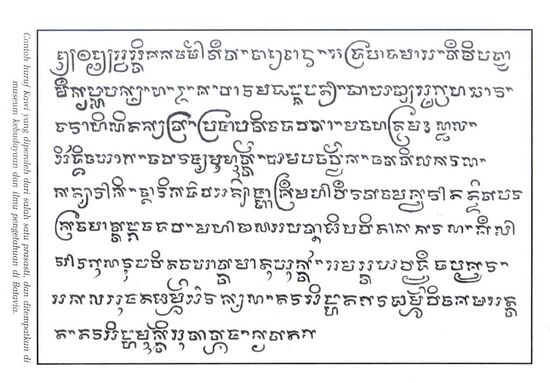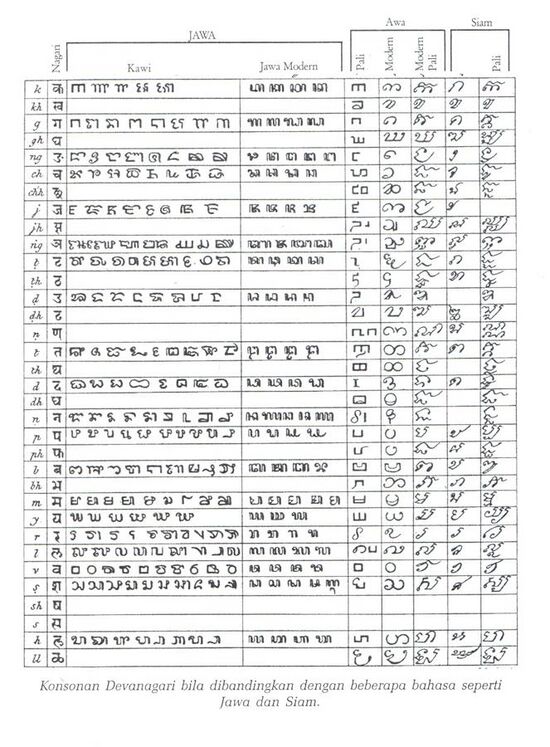Social:Kawi script
| Akṣara Kawi 𑼄𑼒𑽂𑼰𑼬𑼒𑼮𑼶 | |
|---|---|
 'Kawi' in newly standardized Kawi script | |
| Type | Abugida
|
| Languages | Old Balinese, Old Javanese, Old Sundanese, Old Malay, Sanskrit |
Time period | c. 8th–16th century |
Parent systems | Egyptian hieroglyphs[a]
|
Child systems | In Indonesia: Balinese Batak Javanese (Hanacaraka) Lontara Sundanese Rencong Rejang Buda In the Philippines: Baybayin scripts |
Sister systems | Khmer, Cham, Old Mon, Grantha, Tamil |
| U+11F00–U+11F5F | |
[a] The Semitic origin of the Brahmic scripts is not universally agreed upon. | |
The Kawi[lower-alpha 1] or Old Javanese script is a Brahmic script found primarily in Java and used across much of Maritime Southeast Asia between the 8th century and the 16th century.[2] The script is an abugida meaning that characters are read with an inherent vowel. Diacritics are used, either to suppress the vowel and represent a pure consonant, or to represent other vowels.[3][4]
History
The Kawi script is related to the Nagari or old-Devanagari script in India. Also called the Prae-Nagari in Dutch publications after the classic work of F.D.K. Bosch on early Indonesian scripts, the early-Nagari form of script was primarily used in the Kawi script form to write southeast Asian Sanskrit and Old Javanese language in central and eastern Java.[3][5] Kawi is the ancestor of traditional Indonesian scripts, such as Javanese, Sundanese and Balinese, as well as traditional Philippine scripts such as Luzon Kavi, the ancient scripts of Laguna Copperplate Inscriptions 900 A.D. and baybayin that has surviving records from the 16th century.[1] The strongest evidence of Nagari influence is found in the Sanur stone inscription in southern Bali, which consists of texts in two scripts: one in Early Nagari and the other in Early Kawi script. Further, the Sanur inscription overlaps into two languages – Sanskrit and Old Balinese. Of these, the Old Balinese language portion of the text is expressed in both Early Nagari and Early Kawi script. This inscription is likely from 914 CE, and its features are similar to the earliest forms of Kawi script found in the central and eastern regions of the Bali's neighboring island of Java.[6]
According to de Casparis, the early Nagari-inspired Kawi script thrived for over three centuries between the 7th- and 10th-century, and after 910 CE, the later Kawi script emerged incorporating regional innovations and South Indian influence (which in itself is influenced in part by Brahmi-Nandinagari). The four stages of Kawi script evolution are 910–950 CE (east Javanese Kawi I), 1019-1042 (east Javanese Kawi II), 1100–1220 (east Javanese Kawi III), 1050–1220 (square script of the Kediri period).[7]
The earliest known texts in Kawi date from the Singhasari kingdom in eastern Java. The more recent scripts were extant in the Majapahit kingdom, also in eastern Java, Bali, Borneo and Sumatra. The Kawi script has attracted scholarly interest both in terms of the history of language and script diffusion, as well as the possible routes for the migration of Buddhism and Hinduism to southeast Asian region because many of the major scripts of southeast Asia show South Indian Pallava script influence.[4]
The modern Javanese script, state George Campbell and Christopher Moseley, emerged in part through the modification of the Kawi script over the medieval era. This modification occurred in part via secondary forms called pasangan in Javanese, and also from changes in shape.[8] It also shows influence of the northern and western Javanese script forms based on the Pallava Grantha script found in Tamil Nadu as well as the Arabic and Roman script with changes in theo-political control of Java and nearby islands from the 14th- to 20th-century.[9]
Examples
The Kawi script was used in official documents or declarations inscribed in stone or copper tablets primarily in Java but also in other medieval kingdoms in archipelagic Southeast Asia. The following are some examples categorized using present-day states.
Philippines
Lord Namvaran's debt clearance certificate from the Duke of Tondo (900)
An official document written using the Kawi script records the acquittal of Namvaran's debt to the Duke (sena pati) of Tondo in April 900. It is also known as the Laguna Copperplate Inscription.
It records the date of granting of the document being on the 4th of Krishna Paksha (black lunar side), month of Vaishakha, Shaka year 822, corresponding to 21 April 900,[10] and is written in Old Malay containing numerous Sanskrit terms and some Old Javanese and Old Tagalog terms and toponyms.[11]
It was found in 1989[12] at Lumbang River around Laguna de Bay in the province of Laguna near Manila, Philippines.
Butuan seal
The Kawi lettering reads "Butban". The three square seal style characters are BA, TA and NA; the leftward curl underneath BA is the /u/ vowel diacritic, changing the syllable to BU; the small heart-shaped character under TA is the subscript conjunct form of BA which also removes the default /a/ vowel from TA; the large curl to the upper right is the Kawi virama, which indicates the default /a/ vowel on NA is not pronounced. The three blocks of characters together read "[Bu][Tba][N-]. In both Balinese script and Javanese script, which are descended from Kawi, the word is spelled in a very similar pattern, using a similar /u/ diacritic, conjunct form for B, and virama.
Unicode
The Kawi script was added to the Unicode Standard 15.0 in September 2022 based on a proposal by Aditya Bayu Perdana and Ilham Nurwansah.[13][14][2] An earlier preliminary proposal was submitted to the Unicode Technical Committee by Anshuman Pandey in 2012.[1]
The Unicode block for the Kawi script is U+11F00–U+11F5F and contains 86 characters:
Digits
Kawi has its own set of digits:
| 0 | 1 | 2 | 3 | 4 | 5 | 6 | 7 | 8 | 9 |
|---|---|---|---|---|---|---|---|---|---|
| 𑽐 | 𑽑 | 𑽒 | 𑽓 | 𑽔 | 𑽕 | 𑽖 | 𑽗 | 𑽘 | 𑽙 |
| x30px | x30px | x30px | x30px | x30px | x30px | x30px | x30px |
Child systems
Consonants
Gallery
The above is a comparison of the development of Devanagari characters in Kawi, Old Mon of the kingdom of Ava, and Thai script.
See also
- Writing systems of Southeast Asia
- Kawi language
- Vaṭṭeḻuttu script
Notes
- ↑ From Sanskrit: कवि "kavi" lit. "poet";[1] Indonesian: Aksara Kawi or Aksara Carakan Kuna
References
- ↑ 1.0 1.1 1.2 Anshuman Pandey 2012. Preliminary Proposal to Encode the Kawi Script
- ↑ 2.0 2.1 Aditya Bayu Perdana and Ilham Nurwansah 2020. Proposal to encode Kawi
- ↑ 3.0 3.1 De Casparis, J. G. Indonesian Palaeography: A History of Writing in Indonesia from the beginnings to c. AD 1500, Leiden/Koln, 1975, pp. 35-42 with footnotes
- ↑ 4.0 4.1 Briggs, Lawrence Palmer (1950). "The Origin of the Sailendra Dynasty: Present Status of the Question". Journal of the American Oriental Society (JSTOR) 70 (2): 78–82. doi:10.2307/595536. ISSN 0003-0279.
- ↑ Avenir S. Teselkin (1972). Old Javanese (Kawi). Cornell University Press. pp. 9–14. https://books.google.com/books?id=xJ1kAAAAMAAJ.
- ↑ De Casparis, J. G. Indonesian Palaeography: A History of Writing in Indonesia from the beginnings to c. AD 1500, Leiden/Koln, 1975, pp. 36-37 with footnotes
- ↑ De Casparis, J. G. Indonesian Palaeography: A History of Writing in Indonesia from the beginnings to c. AD 1500, Leiden/Koln, 1975, pp. 38-43 with footnotes
- ↑ George L Campbell; Christopher Moseley (2013). The Routledge Handbook of Scripts and Alphabets. Routledge. pp. 28–30. ISBN 978-1-135-22297-0. https://books.google.com/books?id=bLbN4O2EdcsC&pg=PA28.
- ↑ Patricia Herbert; Anthony Crothers Milner (1989). South-East Asia: Languages and Literatures : a Select Guide. University of Hawaii Press. pp. 127–129. ISBN 978-0-8248-1267-6. https://books.google.com/books?id=-EqbeRzdDrsC&pg=PA127.
- ↑ Laguna Copperplate Inscription – Article in English
- ↑ Postma, Antoon. (1992).
- ↑ "Expert on past dies; 82". Philippine Daily Inquirer. 2008-10-21. http://newsinfo.inquirer.net/breakingnews/nation/view/20081021-167699/Expert-on-past-dies-82.
- ↑ "Unicode® 15.0.0". Unicode Consortium. 2022-09-13. https://unicode.org/versions/Unicode15.0.0/. Retrieved 2022-09-13.
- ↑ Unicode Technical Committee 2021. Approved Minutes of UTC Meeting 166
External links
- Omniglot. Kawi alphabet. Retrieved 16 May 2019
- Tiongson, Jaime F., (2008). Laguna copperplate inscription: a new interpretation using early Tagalog dictionaries. Bayang Pinagpala. Retrieved January 14, 2012.
- Lindenberg, Norbert. Repha representation for Kawi
 |



